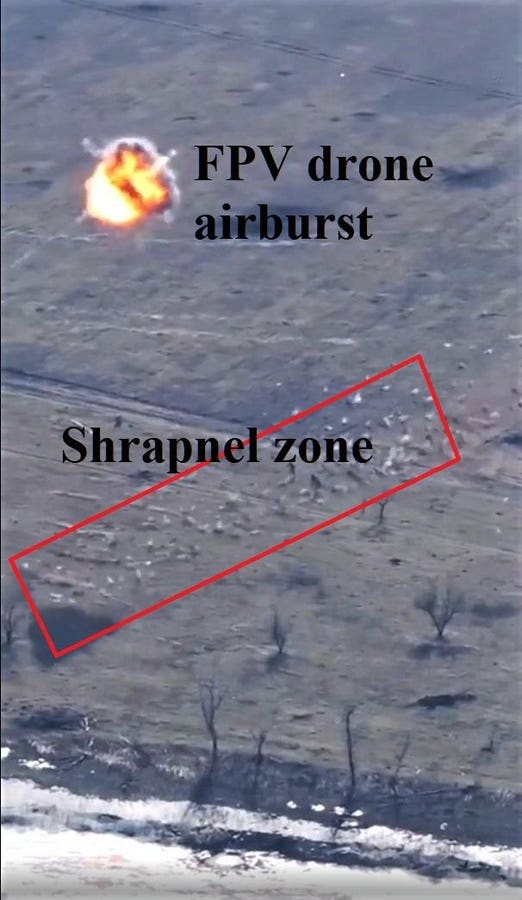FPV drones are kamikaze racing quadcopters, usually carrying an RPG-7 warhead. They are effective against vehicles, from self-propelled guns to personnel carriers and heavy tanks, but individual footsoldiers make difficult targets. Recent videos show Ukrainian forces using FPV drones with airburst shrapnel warheads far more lethal against personnel in the open – in effect, flying Claymore mines.
Small Agile Targets
FPVs are normally fused to explode on impact. This means that, against personnel, they need to score a direct hit or strike the ground close by. The basic RPG
RPG
Soldiers on both sides are aware of this limitation, and FPV operators slow down on the final approach to an enemy on foot. This leads to black comedy videos where the FPV chases the target around obstacles like destroyed vehicles before catching them — or where the target dodges the FPV at the last second and walks casually away.
Engineers on both sides have been looking at ways to make their FPVs more effective against personnel. The recent videos suggest they have succeeded by adapting battle-proven technology.
Front Toward Enemy
The U.S. Army’s M18A1 Claymore Mine is a legend, described by one site as “the world’s most famous mine.” Named after a fearsome medieval Scottish two-handed sword, it is a four-pound munition standing on four short folding legs and consists of 700 steel ball bearings embedded in a curved block of explosive,. One face is prominently stamped with the words FRONT TOWARD ENEMY. (This phrase has become a meme, seen on T-shirts, ball hats and bumper stickers).
Unlike most mines which are set off by the victim, the Claymore is command-detonated: the operator pushes a button on the handheld M57 firing device, connected to the mine by a wire, to blast a wall of shrapnel towards the enemy. This effect covers a 60-degree arc so it is fifty yards wide at a range of fifty yards, and at that distance the cloud of ball bearings is dense enough to virtually guarantee a hit on a human-sized target. Each ball bearing strikes with roughly the force of a bullet. In theory no fragments fly backwards, but a danger zone extends sixteen yards behind the mine where troops are advised to be behind cover.
The Claymore mine was first used in Vietnam in 1966 and soon gained a reputation for annihilating infantry charges. Soldiers even mounted Claymore mines on the sides of armored vehicles as anti-ambush weapons. The design was copied by other countries, and more than a dozen similar munitions are in use worldwide.
In particular, the Russians developed their Minnoye Oskolochonym Napravenien (“Directional Fragmentation Landmine”) series. The MON-50 is a direct copy, with к противнику (“TO THE ENEMY”) printed on the front.
First Drone Claymores
Last March Russian social media carried a video of four FPV drones loaded with MON-50s on a test range with human dummy targets. A month later images on Russian social media showed two different types of small FPV drone with MON-50s attached, and Russian television carried a report with a soldier holding up a drone and describing how it could be armed with a MON-50. But these do not seem to have been used widely, and Russian FPV attack videos continue the show the standard version.
In a discussion last year Steel Hornets, a Ukrainian volunteer group which makes drone munitions, told Forbes they were working on a Claymore weapon for clearing trenches and similar tasks. Last year Russians captured an FPV with a directional warhead. This was not a MON-50 but a smaller, circular improvised device.
As well as preventing the target from dodging, command detonation solves the problem of loss of contact as the FPV drops lower. Mykola Volokhov, commander of the Terra drone unit explained this in a YouTube video on the different types of munition his unit employs. He holds up a plastic disc, the casing for a directional munition specifically designed for FPV use, similar to the one captured by the Russians.
“When the FPV drone approaches the target in the last phase of the attack there is a big problem with communication,” says Volokhov. “As a rule it is lost and the drone…depending on many factors it successfully arrives or it does not.”
This is seen in the vast majority of FPV attack videos: the camera feed cuts out well before impact, because as the drone descends it loses radio contact with the operator because line-of-sight is lost. Having the operator trigger detonation some distance from the target solves this problem.
“This thing produces a directed blast…to hit the enemy in mid-flight, not in contact with the target, by pushing a button,” says Volokhov. “It’s like firing a shot at it, which definitely increases the effectiveness.”
Ukrainian company Shock Wave Dynamics has also shown off directional fragmentation warheads for FPV drones, and Russian videos show that identical units have been captured, indicating they are in use.
Yet another recent captured drone image shows it is fitted with a Chilean M18A1 mine, another Claymore clone.
Munitions which explode in all directions waste much of their blast. But the entire effect of a flying claymore is directed towards the target giving a high chance of a kill.
More Drones Than Soldiers
Recent videos include this one from the Shadow Warriors unit and this one from Moskals, and this one by the Ukrainian 3rd Assault Brigade which shows a high-altitude airburst at :05 which catches a group of Russian soldiers.
The soldiers involved are trained and know to lie down or get behind a tree when an FPV approaches, But this time, the tactic is useless.
In all of these attacks the beaten zone where shrapnel impacts the ground is rectangular, suggesting the warhead is shaped like the original Claymore mine rather than circular. This should make it effective against lines or rows of troops, as well as in clearing trenches.
In the early stages of FPV use in late 2022 they were scarce and employed in small numbers. Now the $400 are increasingly plentiful – Ukraine aims to build a million of them in 2024 and acquire another million from allies. That means that, for less than a billion dollars, Ukraine can individually target every single Russian soldier with a precision guide airburst shrapnel munition.
Small drones may already be destroying more tanks than any other weapon in this war. In the next phase, they may also become the most feared threat to infantry.
Read the full article here





